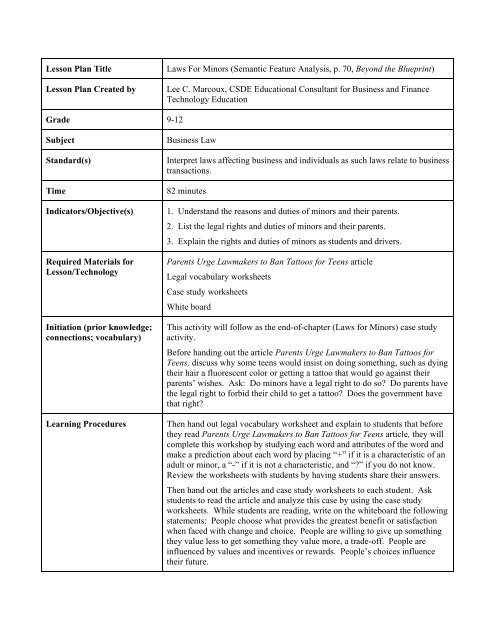Lesson Plan Title
Lesson Plan Title
Lesson Plan Title
Create successful ePaper yourself
Turn your PDF publications into a flip-book with our unique Google optimized e-Paper software.
<strong>Lesson</strong> <strong>Plan</strong> <strong>Title</strong><br />
<strong>Lesson</strong> <strong>Plan</strong> Created by<br />
Laws For Minors (Semantic Feature Analysis, p. 70, Beyond the Blueprint)<br />
Lee C. Marcoux, CSDE Educational Consultant for Business and Finance<br />
Technology Education<br />
Grade 9-12<br />
Subject<br />
Standard(s)<br />
Time<br />
Indicators/Objective(s)<br />
Required Materials for<br />
<strong>Lesson</strong>/Technology<br />
Initiation (prior knowledge;<br />
connections; vocabulary)<br />
Learning Procedures<br />
Business Law<br />
Interpret laws affecting business and individuals as such laws relate to business<br />
transactions.<br />
82 minutes<br />
1. Understand the reasons and duties of minors and their parents.<br />
2. List the legal rights and duties of minors and their parents.<br />
3. Explain the rights and duties of minors as students and drivers.<br />
Parents Urge Lawmakers to Ban Tattoos for Teens article<br />
Legal vocabulary worksheets<br />
Case study worksheets<br />
White board<br />
This activity will follow as the end-of-chapter (Laws for Minors) case study<br />
activity.<br />
Before handing out the article Parents Urge Lawmakers to Ban Tattoos for<br />
Teens, discuss why some teens would insist on doing something, such as dying<br />
their hair a fluorescent color or getting a tattoo that would go against their<br />
parents’ wishes. Ask: Do minors have a legal right to do so? Do parents have<br />
the legal right to forbid their child to get a tattoo? Does the government have<br />
that right?<br />
Then hand out legal vocabulary worksheet and explain to students that before<br />
they read Parents Urge Lawmakers to Ban Tattoos for Teens article, they will<br />
complete this workshop by studying each word and attributes of the word and<br />
make a prediction about each word by placing “+” if it is a characteristic of an<br />
adult or minor, a “-” if it is not a characteristic, and “?” if you do not know.<br />
Review the worksheets with students by having students share their answers.<br />
Then hand out the articles and case study worksheets to each student. Ask<br />
students to read the article and analyze this case by using the case study<br />
worksheets. While students are reading, write on the whiteboard the following<br />
statements: People choose what provides the greatest benefit or satisfaction<br />
when faced with change and choice. People are willing to give up something<br />
they value less to get something they value more, a trade-off. People are<br />
influenced by values and incentives or rewards. People’s choices influence<br />
their future.
Grouping<br />
Guided Practice<br />
Instructional Strategies<br />
Closure<br />
Independent Practice<br />
Assessment based on<br />
Objectives (informal, formal,<br />
formative, summative –<br />
essential question)<br />
Interventions (for struggling<br />
students)<br />
Enrichment (for gifted<br />
students)<br />
Connections to Other<br />
Subjects<br />
Divide students into groups. Each group will have a timekeeper, leader,<br />
presenter and a writer.<br />
Each student in the group will fill out the case study worksheet selecting three<br />
alternatives, why each was chosen, and ranking each by order of importance.<br />
Each group will then make a decision and also fill out a group case study<br />
worksheet and select three alternatives in order of importance.<br />
Students answer questions about how their group reached its decision. Ask<br />
students: Was it a unanimous decision? How did you feel about having to<br />
come up with one group decision? What was your contribution in the decision<br />
making process? The groups will then present their decision and reasons for<br />
supporting their choices. The class would then determine the long-term<br />
consequences for each group’s decision.<br />
Ask students: What have you learned today by completing this case study<br />
about laws for minors? Why are there laws that protect minors? What are the<br />
legal rights and duties of minors and their parents? Explain your rights and<br />
duties as a minor.<br />
Ask students to look in their local newspaper or on the Internet to find other<br />
articles that relate to laws for minors and to bring to article to class.<br />
Students would receive an individual grade and a group grade.<br />
These students can be partnered with one member of their group so they can<br />
receive assistance in completing their legal vocabulary and case study<br />
worksheets.<br />
These students can give assistance to other students who are having difficulty<br />
in completing the legal vocabulary and case study worksheets.<br />
English/language arts and social studies
NAME______________________<br />
LEGAL VOCABULARY (SEMANTIC FEATURE ANALYSIS) WORKSHEET<br />
Before you read the article Parents Urge Lawmakers to Ban Tattoos for Teens, complete the table below<br />
by studying each word and attributes of the word and make a prediction about each word by placing “+”<br />
if it is a characteristic of an adult or minor, a “-” if it is not a characteristic, and “?” if you do not know.<br />
ADULT<br />
MINOR<br />
Adoption<br />
Annulment<br />
Emancipation<br />
Financial responsibility<br />
Guardian<br />
Guardian ad litem<br />
Juvenile delinquent<br />
Majority<br />
Reckless driving<br />
Truants<br />
Parental rights
NAME: _________________<br />
CASE STUDY WORKSHEET<br />
PARENTS URGE LAWMAKERS TO BAN TATTOOS FOR TEENS<br />
CRITERIA<br />
ALTERNATIVES<br />
Rank the criteria<br />
Get a temporary tattoo<br />
Go to a reputable tattoo artist<br />
Have a friend give a tattoo<br />
Don’t get a tattoo<br />
1. Was your group decision unanimous?<br />
2. How did you feel about having to have one group alternative?<br />
3. What was your contribution during the decision making process?
















